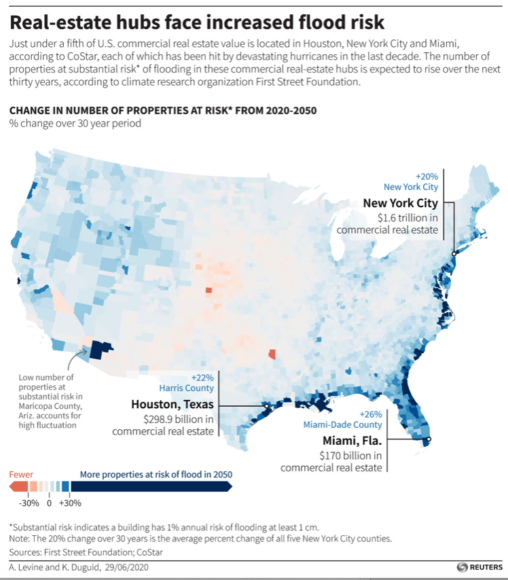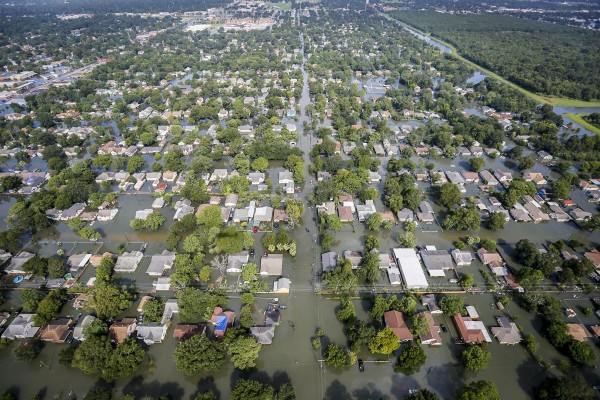The number of properties in the United States in danger of flooding this year is 70% higher than government data estimates, research released on Monday shows, with at-risk hot spots in Houston, New York, Los Angeles and Chicago.
The higher risk identified could have implications for property values as well as insurance rates, municipal bonds and mortgage-backed securities, according to investors and researchers at First Street Foundation, which released the data.
“This could change the calculus on whether a given property is resalable, or what price you sell it at,” said Tom Graff, head of fixed income at Brown Advisory.
The data, which covers the contiguous United States, found that around 14.6 million properties, or 10.3%, are at a substantial risk of flooding this year versus the 8.7 million mapped by the Federal Emergency Management Agency (FEMA).

FEMA maps are currently used to determine rates on government flood insurance and underpin risk assessments done by mortgage lenders, investors and home buyers. The maps, however, only account for coastal flooding – not rain or rivers – and do not incorporate the ways climate change has made storms worse.
A FEMA spokesperson said that First Street’s maps build on those created by the agency and the two are not incompatible.
Los Angeles, Chicago, Houston, New York and Cape Coral, Florida top First Street’s list of cities with the most number of properties at risk. At the state level, Florida, Texas, California, New York and Pennsylvania have the most to lose. Florida and Texas also top FEMA’s list, but with significantly fewer properties estimated to be at risk.
Washington, D.C., has the greatest deviation from FEMA’s numbers, 438.4% more properties at risk, because First Street accounts for potentialflooding from the Potomac and Anacostia rivers and a drainage basin under the city. Utah, Wyoming, Montana and Idaho have the next highest deviations, all between three to four times greater than FEMA estimates.
Commercial mortgage-backed securities (CMBS), investments that pool loans for office buildings, hotels, shopping centers and more, are among the securities most exposed to flood risk because of the concentration of cities on the U.S. coasts.
“There is a moral hazard within the investment community of not pricing in the risk of something like this happening,” said Scott Burg, chief investment officer at hedge fund Deer Park Road.
Nearly 20% of all U.S. commercial real estate value is located in Houston, Miami and New York, according to CoStar data, each of which has been hit by hurricanes in the last decade.
Hurricane Harvey, which slammed Houston in 2017 and caused $131 billion damage, affected over 1,300 CMBS loans, 3% of the CMBS market in 2017, according to BlackRock research. Hurricane Irma in 2017 affected 2%.
The BlackRock report concluded that 80% of the commercial property damaged by those two storms was outside of FEMA flood zones, indicating that many of the buildings hit may not have been appropriately insured.
Any floods this year could compound the effects of the coronavirus pandemic, which has sent more than $32 billion of commercial loans into special servicing – negotiations for relief in the event of a default – according to Moody’s.
“For property owners that’s like getting your arm amputated and then your head lopped off,” said Jacob Hagi a professor of finance at the University of North Carolina and a First Street research partner.
Was this article valuable?
Here are more articles you may enjoy.


 Florida And East Coast Will See Big Losses From More Cat 5 Storms, Researchers Say
Florida And East Coast Will See Big Losses From More Cat 5 Storms, Researchers Say  Abbott Presses Congress for Shield Over Preemie Baby Formula Litigation That Could Cost It Billions
Abbott Presses Congress for Shield Over Preemie Baby Formula Litigation That Could Cost It Billions  Tricolor Trustee Plans to Sue Founder for Auto Dealer’s Collapse
Tricolor Trustee Plans to Sue Founder for Auto Dealer’s Collapse  State Farm Sued Over Policies Backed by Distressed Insurer PHL
State Farm Sued Over Policies Backed by Distressed Insurer PHL 